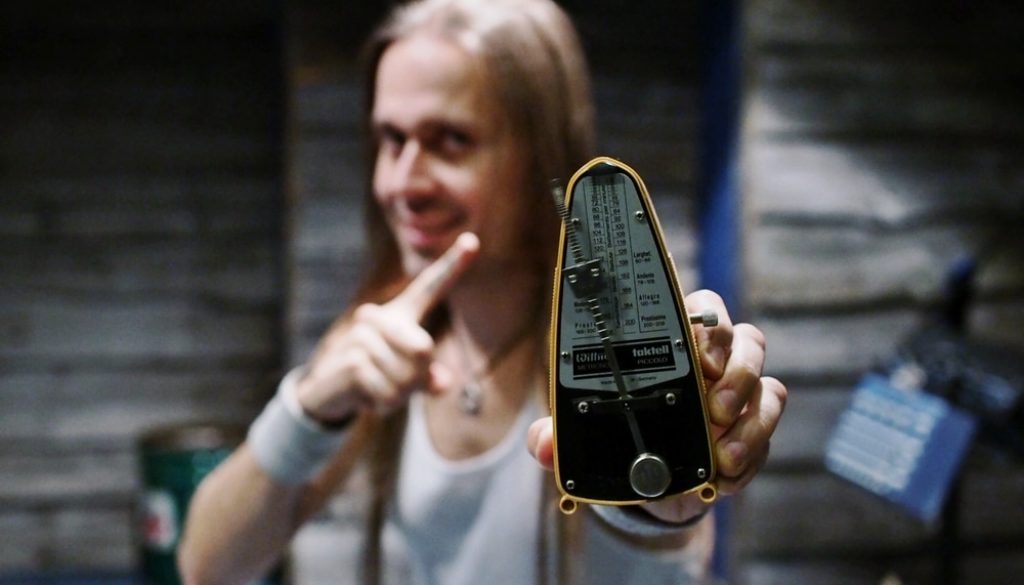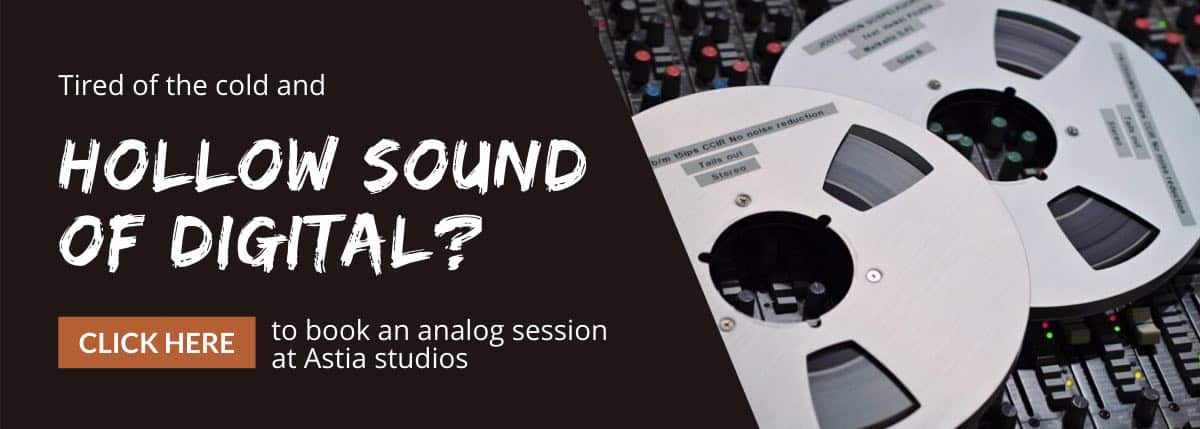The tempo and how it should not be chained
Keeping the tempo while playing is something to aim for. At both the rehearsals and live shows a metronome helps to keep the song from swaying rhythmically. Yet, how was it back in the time of classic albums? Let’s talk about the tempo and how it should not be chained. We’ll inspect some of the heavier classic songs and I will give you tips on how to improve your ear when it comes to the rhythm.
Whether you are a drummer, guitarist, bass player or work with sound, you will find this writing helpful. So let’s get started, shall we.
The tempo and how it should not be chained
Lately I’ve bumped into an alarming phenomenon where the drummer is unable to keep the rhythm without a metronome. A digital native is quit a common term, but have you heard about a drummer who is a metronome native?
Metronome as a tool comes in handy and several tempo-related phone applications can help you a lot. Yet, I find it highly worrying when not using a metronome causes insuperable problems keeping the tempo steady.
It is comparable to a situation where at the band rehearsal those who play string instruments had forgotten to bring in a tuner. As tuning without a tuner would be impossible, the rehearsal would be cancelled. Not a single note would be played and the members would have to go home without experiencing the joy of music…
I have a very clear memory of the time in my teens when none of the band members had a tuner. We went to the rehearsal room and tuned our instruments according to the note A that sounded most appealing. We didn’t let the not-having-a-tuner be an obstacle to our passion. Playing music together was the best and we spent at least 5 nights a week at the rehearsal room!
Is it ok for a tempo of the song to be alive?
Earlier, especially during recording, I wanted to have the control over every single detail. The tempo needed to be strict without any deviation. We planned each part and note before even considering to start the recording.
Now I have understood the negative effect of such bossying when it comes to music especially and nowdays I have the opposite approach. We use metronome to get the starting tempo only; to have just two bars of metronome before the song starts. This way we’ll make sure that the song always starts the same.
I recommend you too to listen classic albums from the time when metronome wasn’t used during recording and especially at the live shows. Many of those albums deliver the joy of playing and some have even managed to capture a very special moment. Something that wasn’t planned, yet it raised the song to a whole new level!
My personal opinion is that the song tempo needa to be alive. Every part should have the beat that suits it the best. The click natives mentioned in the beginning of this post might be the only exception to this rule. If playing without a metronome turns out to be impossible, then you should play using a click track.
Or maybe it would be worth to learn to play rock steady without the metronome. After all, it isn’t that hard. We all have learnt to drive a bike without the training wheels too. Yet, at first we all were sure it wouldn’t be happening during this lifetime.
Some examples of the tempo being alive
I vividly remember how huge impact the early Metallica albums had on teenage Anssi. Never in my life had I heard such energy when it came to music!
There are several tips about the tempo that I now want to share with you. I hope they will give you new insight and inspiration on riffs, composing and playing.
With the following examples I want to show you how playing without a metronome can be an excellent idea. You can study the tempo using an app or better yet just by listening without the help of any technical device. After all, when it comes to sound you should always use your ears rather than your eyes.
Metallica – Master of Puppets
Right from the start the tempo is nicely alive. When the beats comes in and also at the end of each riff-cycle when there’s a tresillo aka 3-3-2, the rhythm isn’t too strict. I think this sounds excellent and represents the aliveness in playing that I recommend all drummers to learn.
On the verse riff you count to 4 and at the end of the riff-cycle to 3. Can you spot that the ending isn’t exactly on the grid? If it would be, I highly doubt that this classic performance would be as popular as it even today is. That little aliveness at the end of each cycle gives it a specific flavour. We can almost feel how the enthusiastic teenagers are rocking away the music they love the most with huge emotion!
Especially the odd time signatures like 7 as in this example, sound a lot more natural when you play without a metronome. I had an interesting experience few years back when recording God Is Dead song for the latest Ensiferum album. The demo version was played to a click and in the mid-part the drummer flips the beat over for few bars. It sounded very unnatural on the demo. I managed to lure the band to perform the album track without a metronome and it made flipping the beat sound much more natural. This is a small, yet highly important remark.
The verse on Master of Puppets is a bit more slower compared to the intro. If it wasn’t the vocals would sound too fast. And even though the genre is trash metal, it doesn’t necessarily mean that you have to play the parts too fast. I find the aliveness of the tempo in the chorus highly appealing and it would feel very unnatural if it was too strict.
If there is someone with too much time on their hands, you should try editing these classic performances to grid. This way we could compare which version would sound more inspiring. I love this nicely alive original version which is positively pretty far from grid.
Stone – Back to the Stone Age
The producer/recording & mixing engineer Mr Mikko Karmila said that they used a metronome only on the beginning of the songs on this classic masterpiece. To me as well as for Alexi Laiho and Antti “Hyrde” Hyyrynen this is one of the most important albums of the teenage years. It had a huge impact on us that can be heard once you know where to look. One of the reasons is that the songs are not played using a metronome thru-out the songs.
Listen to Back to the Stone Age song and count how many times the tempo changes. When the double bass drum part comes the tempo slows down a bit so that the drummer manages to play the part right. What if this is the reason why you have problems with the double bass drum parts? Maybe the tempo you have is simply too fast and should slow down at least a bit.
Stone – No Anaesthesia
I cannot help but to take another example from this awesome album. Inspired by it I want to give you homework or perhaps it should be called rehearsal place fun. Record the main riff of the song at the rehearsal room alone or with your bandmates both with and without a metronome. Do your best to make the part groove. It is a very different thing to play a pattern correct rather than to make it flow just the right way aka in groove.
When the half feel comes, the tempo drops down and on the individual hits part it goes back up. I don’t think these guys were thinking about or listening any BPM’s when this song was composed and captured.
Have you noticed the 6:20 rising part and how it slows down? Or how the tempo is alive on the next slow riff before the solo, where they play to 7 (4+3). This is a great example of something that is completely missing from the music made today.
Annihilator – Alison Hell
Let’s stick with the same era hit song and inspect the first single from the debut album of Annihilator. On the first bars with the clean guitar you can feel that there is no metronome used. When the drums start the tempo jumps up pretty radically.
As the intro moves to a faster pace, at the end of each riff-cycle there’s again this nice tempo sway. This riff either isn’t on grid and that’s exactly how it works the best. I doubt if they would ever have gained any popularity if the song was played to a metronome or edited to grid…
A cool pattern that slows down leads us to another clean guitar part. The rising part has yet another tempo change. How many times the tempo has changed before we get the to riff at the beginning of the first verse? Now this is what I call a creative composition.
The old music had plenty of aliveness
Listen to Abraxas album by Santana released in 1970. The last song on side A has some pretty cool tempo changes that I very much like. I welcome such riffs on modern music too with open arms regardless of the genre.
Also in 1970 Close to You album by The Carpenters was released. Listen to the amazing 3rd last song on side B; Mr. Guder. Think how they managed to pull of the tempo changes including the a cappella parts. Despite the lack of a metronome, the parts are tight and work great also when it comes to the rhythm. Would anyone be willing to try a similar recording technique today; on tape and without a metronome?
I should mention Suicidal Tendencies‘ Institutionalized, Metallica‘s Sad But True, the classic albums of Iron Maiden, King Diamond albums until Conspiracy, Rage Against The Machine and let’s say System Of A Down band for example. System Of A Down band for example. To play along and study those artists and their albums will give you new aka old insight when it comes to using a metronome. Meaning: not using a metronome.
More to study
Every musician will benefit from listening to others and it’s a part of the rhythmic accuracy. As a teenager I learnt to play the guitar along with my favourite albums. It was a great school especially when it came to the rhythm and tightness. At the time I was mostly listening to the heavy metal of the 80’s. This made me very familiar with the music from Iron Maiden, Stone, Metallica, King Diamond and many many others.
I warmly recommend you to not only listen to these classics but also to play along with them. A guitarist and a bass player can easily play along at home. The drummer can do like when making a drum cover; go to the rehearsal room and feed the music to the headphones using a cassette, vinyl, CD or maybe even from Spotify. This will teach you to listen to the other instruments eventually making you improve your timing and tightness.
The only downside is if you start programming a click track to be able to play along. Then you no longer play with your favourite band as you are tied to the metronome.
I warmly recommend to avoid using closed headphones when playing the drums. They prevent you from hearing the drum set acoustically and hide the balance you play. Even though you focus on listening to others, it’s good to hear yourself too. This will help you improve the balance of the drum kit and how you play it.
Bring influences from those classic albums to your music and use a metronome just to get the starting tempo. This will help you find what music is all about and to enjoy playing even more!
Read more: To Metronome Or Not
Do you what makes you happy
Thank you very much for reading my thoughts about metronome and how to use it as a tool rather than a necessity.
Music has become something that no longer touches the listener. You can’t tell bands from apart as they all sound the same. The sense of danger that is still present on the old classic albums seems to be almost extinct. So make a change and be different. Stand out from the masses!
If this post was helpful, please share it on social media. This way you will help your friends to benefit from the information.
If you are tired of the metronome, editing, drum samples and sound replacing reserve a tape recording session with me at Astia-studio by clicking here. Thank you very much and all the very best!
Astia-studio is a full analog recording studio located in eastern Finland with 25 years of experience. Bands and artists from all over the world including USA and the furthest corner of Russia, Vladivostok have arrived to us for tape recording sessions.



